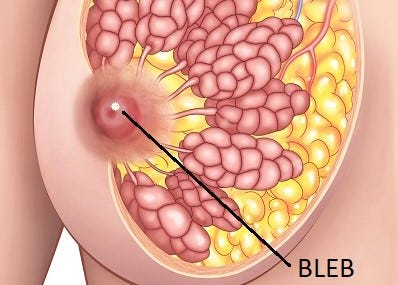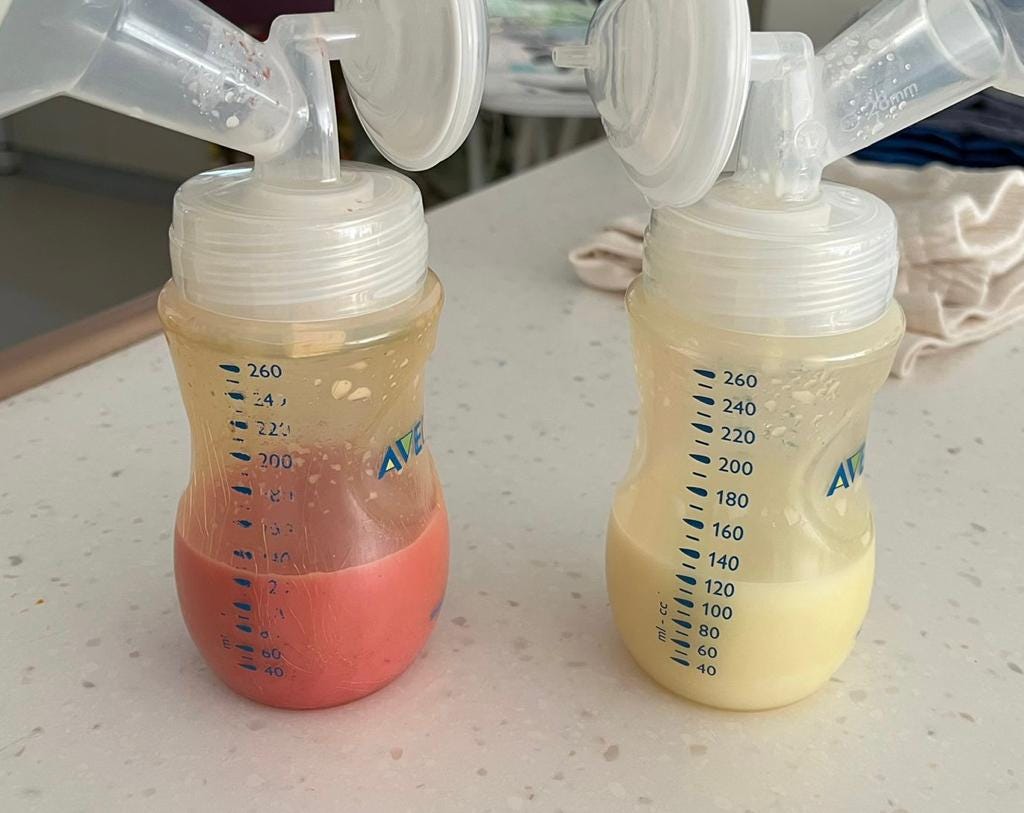Breastfeeding Blues: Clogged Ducts, Milk Blisters, and Mastitis
How to identify, treat, and prevent these problems
I consider myself a battle-scarred, breastfeeding veteran. Not just because I've "done" breastfeeding, but because I've experienced the whole trifecta of clogged ducts, milk blisters and mastitis. I've even had the pleasure of waking up to strawberry milk.
Breastfeeding conditions are painful and frustrating, but I hope I can help you effectively self-diagnose, manage and prevent these conditions.
Clogged Ducts
A clogged or blocked milk duct is a hard, tender lump that forms in the breast due to milk not moving well through the ducts. It's often accompanied by inflammation and can cause discomfort or pain. This typically happens when the milk isn't efficiently removed during breastfeeding, leading to a build-up. You'll notice decreased milk flow from the affected breast, and you might feel fullness in the breast even after a big feed.
Treatment:
Warning - There is no pleasant way to manage a clogged duct.
Take a hot shower or bath. Use your hands to "massage" (i.e. squeeze the shit out of) your breast, starting from behind the lump, and moving towards the nipple. This will mostly likely take multiple sessions of repeated squeezing. It will either gradually get better, or all of a sudden milk will start spraying out to celebrate your success
If self treatment doesn't work, then I highly recommend that you get ultrasound therapy from a physiotherapist, especially if you have insurance. During an ultrasound therapy session for clogged ducts, a small handheld device is placed on the affected area of the breast. It warms up the breast tissue, and emits sound waves to create vibrations to loosen up your ducts and break up the blockage. The physiotherapist will then help you squeeze out your blockage. After this procedure, you should rush home and breastfeed as soon as possible to drain it further.
Prevention:
The key is to ensure efficient milk removal.
Right before breastfeeding or pumping, you need to "loosen up" your milk ducts. You can do this by putting a warm compress over your breasts
After breastfeeding, if you still feel fullness in your breasts, you should pump to empty your breasts. If it's almost empty, you can hand express until your breasts are completely soft. This helps to keep the milk flowing and reduces the chances of milk build-up.
If you’re drinking lactation soups or eating lactation cookies but already getting adequate supply, stop. You likely have an oversupply issue, and there’s no need to trigger it more to result in a blockage.
Milk Blisters or Milk Blebs
Milk blisters, or blebs, differ from clogged ducts in that they are tiny milk-filled or skin-covered sacs on the nipple that block the flow of milk. They form when a skin layer grows over a milk duct opening and milk backs up behind it.
Treatment:
Do NOT pick or try to pop a milk bleb. This could further damage your skin, intensify the pain, and even lead to an infection.
Word on the street is, applying warm compresses can help to soften the skin and relieve the blockage. Gentle nipple massage can also aid in opening the blocked duct. This worked for my friends but didn't work for me.
The magic medicine for me was epsom salts. Fill up a Hakaa halfway with hot water and a big pinch of epsom salts. Put the hakaa over your affected nipple and lay down for 10 minutes. The suction of the hakaa puts pressure on the milk blister, while the epsom salts just work its magic (tons of Youtube videos on this). Afterwards, try to pump if it's not too painful, otherwise hand-express. This could take multiple attempts.
Breastfeeding in an "aerial" position where you're leading over the baby may be helpful for women with milk blebs on the lower part of the breast. Gravity helps the milk flow downwards. However, it is not comfortable at all.
If self treatment doesn't work, you can see your GP and they might recommend a small procedure to clear the milk blister
Prevention:
Empty your breasts
Use a warm compress before breastfeeding
Wear loose-fitting shirts and a well-fitted bra that doesn’t put pressure on your milk ducts
Cracked or damaged nipples can increase your risk of developing a milk bleb. Take care of your nipples by using a lanolin cream or other nipple cream and avoiding harsh soaps or lotions that can dry out the skin.
A word on strawberry milk:
Around the same time I was self-treating my milk blister, I woke up to this. I freaked out, my husband freaked out, and I bolted to my GP. The doctor determined that the root cause was blood from my damaged nipples since I was hand-expressing too hard.
In most cases, it's safe to keep breastfeeding your baby and it helps you clear blockages. Your baby may or may not notice the change in taste. If your baby won't take to the breast, then you'll just have to pump and dump, and try not to to manhandle your affected breast too hard to allow it to heal.
Mastitis
Mastitis is an infection of the breast tissue that results in breast pain, swelling, warmth, and redness. You might also experience flu-like symptoms such as fever and chills.
Mastitis is often caused by clogged ducts or milk blisters that haven't been effectively managed, so the key to avoiding mastitis is to prevent clogged ducts and milk blisters through effective drainage of your breasts.
Treatment:
If you have mastitis, it's crucial to maintain milk flow. Continue breastfeeding if possible, otherwise switch to pumping, even though it is extremely painful.
You will need to see a medical practitioner. Left untreated, mastitis could escalate into becoming an abscess. Your doctor will likely prescribe antibiotics to treat the infection, and over-the-counter pain relievers can help manage discomfort. Your doctor may also squeeze on the clog for you (it will hurt like a mother - there is no way to mince my words)
Remember, breastfeeding is a choice
It's important to remember that breastfeeding, as with all things in life, comes with its ups and downs (definitely came with more downs for me). These issues are common and often temporary if you manage the effectively. As you grow more experienced and comfortable with breastfeeding, it gets easier. Take comfort in the knowledge that you're providing your child with amazing nutrition, and remember, this too shall pass.
If your breastfeeding blues are recurrent and you feel yourself losing your mind, remember no one is putting a gun to your head to force you to breastfeed. You can always switch to formula. Whatever you decide, you're doing a great job, mom!







